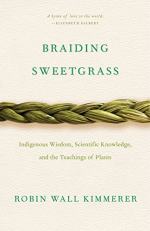
|
| Name: _________________________ | Period: ___________________ |
This test consists of 15 multiple choice questions and 5 short answer questions.
Multiple Choice Questions
1. What word refers to the sacred tobacco among the author's people?
(a) Sema.
(b) Wiingaashk.
(c) Yawe.
(d) Wabunong.
2. What is the Anishinaabe word for maple?
(a) Anenemik.
(b) Ode'mini-giizis.
(c) Wiingaashk.
(d) Yawe.
3. Who wrote The Mishomis Book?
(a) Eddie Benton-Banais.
(b) Awiakta.
(c) Tom Touchet.
(d) Bruce King.
4. What grew from Skywoman's daughter's head when she was buried in the earth, according to the author in "Epiphany in the Beans"?
(a) Tobacco.
(b) Onions.
(c) Sweetgrass.
(d) Wild strawberries.
5. What Swedish botanist does the author reference in "In the Footsteps of Nanabozho: Becoming Indigenous to Place"?
(a) Elias Magnus Fries.
(b) Carl Linnaeus.
(c) Carl Peter Thunberg.
(d) Olof Swartz.
6. How do Nanabozho's people know time, according to the author in "In the Footsteps of Nanabozho: Becoming Indigenous to Place"?
(a) As a circle.
(b) As a triangle.
(c) As a mountain.
(d) As a road.
7. Who is described as the late bloomer of the family in "The Three Sisters"?
(a) Corn.
(b) Onions.
(c) Squash.
(d) Beans.
8. What is left as a reciprocating gift when an ash tree is chosen to be cut down by the author's native people?
(a) Coffee grounds.
(b) Tobacco.
(c) Beans.
(d) Corn.
9. In the author's metaphor for the Three Sisters as an emerging relationship between Western science and indigenous knowledge, the corn signifies what?
(a) Science.
(b) Spirit.
(c) Traditional ecological knowledge.
(d) Community.
10. What is the author's people's word for cedar?
(a) Kizhig.
(b) Makaks.
(c) Puhpowee.
(d) Zhawanong.
11. What did the Mohawk call themselves, meaning "People of the Flint" (304)?
(a) Kanienkeha.
(b) Zhawanong.
(c) Zizibaskwet Giizis.
(d) Wabunong.
12. How many weeks were the author's students required to stay at the Cranberry Lake Biological Station as a graduation requirement, according to her narrative in "Sitting in a Circle"?
(a) 9.
(b) 2.
(c) 5.
(d) 6.
13. What is one of the names for the cattail in the Potawatomi language, meaning "we wrap the baby in it" (275)?
(a) Zhawanong.
(b) Hierochloe odorata.
(c) Bewiieskwinuk.
(d) Zizibaskwet Giizis.
14. Where was the Carlisle Indian Industrial School located?
(a) Pennsyvania.
(b) New Hampshire.
(c) Connecticut.
(d) Texas.
15. How many growth rings does John Pigeon prefer for a black ash tree for basket making?
(a) 30-40.
(b) 20-30.
(c) 10-20.
(d) 40-50.
Short Answer Questions
1. According to the beliefs of the author's people, what does East represent?
2. What grew from the heart of Skywoman's daughter, according to the author in "Epiphany in the Beans"?
3. From where was the emerald ash borer introduced?
4. What did Laurie's finding show happened with harvested sweetgrass in her graduate thesis?
5. Who gave Nanabozho the shape for his canoe, according to the narrative in "In the Footsteps of Nanabozho: Becoming Indigenous to Place"?
|
This section contains 423 words (approx. 2 pages at 300 words per page) |

|




